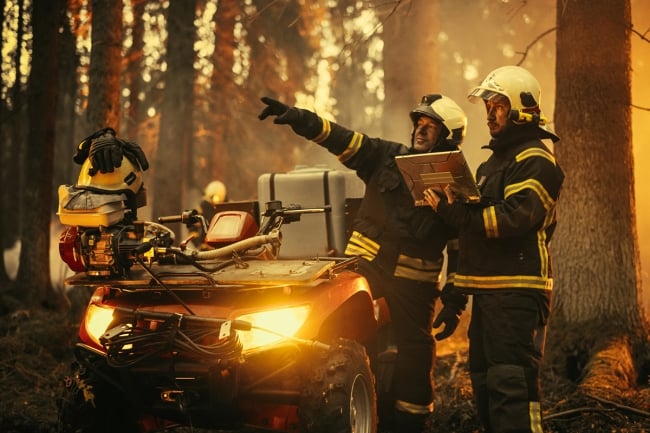You have /5 articles left.
Sign up for a free account or log in.

Firefighting company officers are taught how to take what they’ve learned and effectively pass that knowledge on to their peers back home. The principles of the train-the-trainer model can be equally impactful for student support in higher ed.
gorodenkoff/iStock/Getty Images Plus
Higher education is facing a growing completion crisis. There are now 40 million people in the United States who earned some college credits but never graduated. In the 2021–22 academic year alone, 2.3 million learners stopped out. Of the undergraduate students currently enrolled, one-quarter have seriously considered dropping out or are at risk of being dismissed, according to a recent survey released by Sallie Mae. Citing financial hardship, declining motivation and mental health challenges, these learners are grappling with significant barriers to completing their degrees.
These challenges couldn’t come at a worse time for institutions already experiencing mounting financial, economic and political headwinds. In my role as executive director of the National Institute for Student Success (NISS), I work with college leaders every day. While they are well aware of the dropout crisis, finding much-needed resources—from funding to human capital—to address it is easier said than done. Already, more than one-third of college and university employees report frequently experiencing burnout, positioning them among the most overwhelmed employees in any industry in the country.
Historically, many institutions have looked outward to fill gaps in student services and support. But college leaders are learning that, while partnerships with external organizations can have a significant impact, their benefits can be limited to the duration of the business relationship. Outsourcing student success can only get an institution so far. Tackling the enrollment and retention crisis facing higher education requires creating lasting, sustainable capacity from within an institution’s existing ranks. To address these challenges, colleges can draw inspiration from an unexpected source: wildfire management.
As communities across North America gear up for another potentially record-breaking and devastating summer wildfire season, firefighters are once again relying on a strategy known as train the trainer. The U.S. Forest Service, state agencies and firefighting academies provide in-depth training to company officers that allows them to hone critical wildfire and crisis management skills. Crucially, they are also taught how to take what they’ve learned and effectively pass that knowledge on to their peers back home. This cascading effect enables emergency and wildfire responders to build a workforce capable of tackling wildfires—and, as much as possible, preventing them.
Train-the-Trainer Cases to Consider
In use across a range of other industries—from health care to customer service—the principles of the train-the-trainer model can be equally impactful in student support. Indeed, some institutions have already embraced the strategy.
The Austin Community College District engaged student success and coaching experts from the nonprofit InsideTrack to help boost the retention and completion rates of its students. The sixth-largest community college in the U.S., ACC serves tens of thousands of learners, many of whom face financial challenges, including food and housing insecurity. While the partnership provided an initial wave of ACC students with personalized success coaching, a select group of staff members also received training on how to integrate those same techniques into their existing advising practices—and, in turn, train new coaches.
As documented in a recent InsideTrack report called “Empowering Teams, Improving Outcomes,” nearly 100 staff members received the training and 70 were certified as coaches, kicking off a chain reaction that expanded the program’s impact across ACC’s 11 campuses and long after the partnership ended.
There are other examples.
In 2022 the NISS was engaged by a group of seven public universities in Georgia to work directly with college leaders and professional staff members on each campus, teaching them how to overcome campus silos and to deploy new student support approaches such as predictive analytics, proactive advising and AI-enhanced chat bots.
Within 18 months, the average retention rates across the seven institutions had improved by 8.8 percentage points—about five times the national gains over the same time period. At Albany State University, the largest HBCU in Georgia, retention rates for Black students improved from 58 percent to 80 percent.
What’s Needed for Change
Such transformative results are only achieved by finding innovative ways to invest in existing infrastructure to boost internal capacity. If that sounds like hard work, it’s because it is. It requires not only training and development of faculty and staff, but also implementing effective change management across the entire institution.
Without buy-in from both front-line student support staff and senior leadership, any training and development program—no matter how promising—is unlikely to succeed. Leaders need to clearly and consistently communicate their genuine investment in the initiative, make time and space for impacted teams to ask questions or share concerns, and create feedback loops to help staff understand the progress that’s being made.
But when done right, this train-the-trainer model creates lasting change. Two decades ago, Georgia State University, where the NISS is headquartered, embarked on such an effort to reimagine our approach to student retention and success. Since 2003, the university has improved its six-year graduation rate by 23 percentage points and eradicated achievement gaps based on race, ethnicity and income. While our use of predictive analytics played a core role in our efforts, the university’s steadfast commitment to building a durable and sustainable infrastructure for delivering responsive student support proved just as crucial, if not more so.
The real catalyst for change was not any single tool, partnership or person, but a deliberate campuswide shift toward a culture wholly oriented around, focused on and driven by improving student outcomes. This fundamental shift is what allows institutions to enhance and sustain holistic, human-centered student support.
Today, most college leaders know making investments in strengthening student support and improving retention is not only an act of beneficence but a moral and fiscal imperative. The question is no longer whether to make those investments but how to find the capacity to do so. And the answer lies in investing in people.
Just as wildfire management relies on a continuous loop of training to create a ripple effect of knowledge and preparedness, so too can higher education develop a self-perpetuating—and capacity-building—cycle that allows all students to not only persist but thrive.








